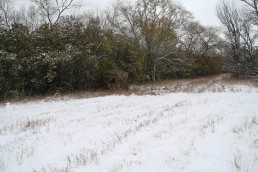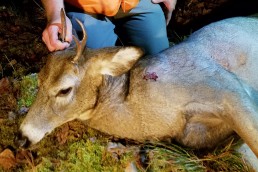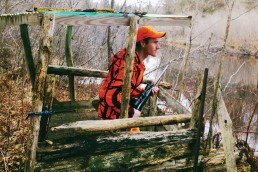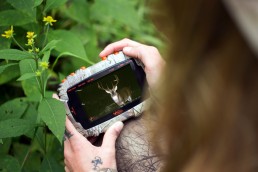Find the Food to Fill that Last-minute Buck Tag
SHARE THIS POST
Despite the snow swirling around me, I pushed through the thick brush, spurred onward by an unfilled buck tag in my back pocket. I carefully climbed 20 feet up into my treestand, swept the snow from the seat and settled in. By the time I got my bow towed up on the haul rope, a buck appeared at the woods line and began to move across the harvested cornfield toward me. My plans for a long, cold vigil suddenly changed and this buck’s appearance created a flood of optimism that this night might be the night.
I love hunting the last days of archery season despite the nasty weather because I have so many good memories and successes to show for it.
Many states have bow and muzzleloader seasons that last beyond Christmas well into January. The key to success for me has been the understanding that deer have different needs during cold weather than they do during the rest of the season.
There are three macronutrients that all humans and animals need: protein, carbohydrates and fats. Understanding when bucks crave these nutrients and where they will find them goes a long way toward figuring out their movement patterns, particularly during the late season, when their patterns become quite predictable. By examining where the deer find what they need to eat on a daily basis and where they bed, we can put together a pattern for intercepting them on their daily travels to and from these locations.
Why deer crave protein and carbs
After the rut, bucks are run down. Their fat reserves are gone and their muscle mass is diminished. Nothing restores muscle faster than protein, and soybeans are loaded with it. Field corn is very high in carbohydrates, which help restore fat reserves. And most mast crops are high in carbohydrates and fat. Acorns, especially the meaty varieties like those from white oaks, offer a large dose of fat and carbs. Honey locust pods are high in proteins and fats too—you get the idea.
Cornfields left standing in December into early January will be swarmed by deer. And in cut cornfields, deer will glean waste corn from the ground as long as it is available. They can also easily smell a single kernel through a foot of snow.
Interestingly, deer can eat raw soybeans, which are toxic to humans and any animal with only one stomach. Since soybeans provide quick energy through a combination of proteins and carbs, deer will often seek them out during the coldest weather. A stretch of nights with below-zero temperatures will move deer off the corn and acorns and onto the soybeans because of the quick turnaround of energy they offer. During these periods of extreme weather, immediate energy for body heat is more important that storage of fat. Food plots of soybeans or late-standing soybean fields attract more deer than corn does during the harshest, coldest weather patterns. When it moderates somewhat, they may move back to the high-carb food sources.
Standing cornfields offer a combination of bedding cover and feed. During mild stretches of the early winter deer stay in the corn around the clock. They feel safe in the cover and it provides protection from the wind, as well as giving them a food source within reach.
So, bucks are seeking out specific kinds of foods based on which foods are higher in carbs or proteins and will gravitate toward the food sources that offer the combination they need at that given time. But mature bucks especially do not blindly wander around looking for these foods, as there are other factors involved.
Escape cover
A mature buck will not feed in the open unless he feels secure and has an avenue of escape. The best places to find these afternoon feeders is where they have a brushy draw they can dive into at the hint of danger, or a creek-bottom thicket along the edge of the field. I have even seen them disappear into a big field of tall cover such as switchgrass or scrub cedars.
Are you enjoying this post?
You can be among the first to get the latest info on where to go, what to use and how to use it!
If you can find these avenues of escape, you have the beginning of a pattern that could put that buck in your truck because these deer will often enter the field from this escape cover.
Thermal cover and bedding areas
When not feeding, bucks need to feel secure in bedding areas that provide them protection from the elements. Thick cover offers cover from biting winter winds, and on cloudy or snowy days, most deer will be tucked in tight right in the middle of the thickest stuff around. And, they will use the same beds day after day.
Solar bedding areas
The second most common bedding areas in winter are south-facing open slopes that get a lot of sun. Whitetails tend to use these when there is little wind and they can soak up the sun’s warming rays. Look for open timber where the sun can get through. These areas will typically have a lot of beds because the deer will get up and move as the shadow of a tree falls on them. So they may actually use three to four beds during the course of the day.
Intercepting the bucks
Well-worn trails provide evidence of travel patterns that can help the bowhunter decide where to set up an ambush. A ground blind along the edge or blended in with cornstalks right in the middle of the food is often the perfect spot. When setting up over a vast field, keep in mind that the tops of hills are often cleared of snow by the wind and offer deer the easiest access to the food.
It is very common for bucks to approach the field through the escape cover and make their way out into the field cautiously. The most mature bucks though, will typically enter the field last.
A bowhunter must get up close and personal when in a treestand. And that generally means setting up off the field a ways and back up the trail. Often, mature bucks will hang up for a while before entering the field. A bowhunter in a treestand 50 yards from the field’s edge may have the advantage of getting a shot at a buck that won’t expose himself in the open field before dark. A hunter carrying a muzzleloader can set up on the edge of a field or even right in the field itself.
Hunting last-minute whitetails is a game of making educated guesses as to where to be, and when. The more information you have, the more educated your guess will be.
Bernie Barringer has hunted big game with a bow in more than a dozen states and in multiple Canadian provinces. Passion drives him to learn more and hunt new places, and this column is your ticket to his travels. The author of 13 books and thousands of articles, you can find even more from him at bowhuntingroad.com and BowhuntingRoad on YouTube.
MWO
SHARE THIS POST
Did you enjoy this post?
You can be among the first to get the latest info on where to go, what to use and how to use it!
Bernie Barringer
Bernie Barringer has hunted big game with a bow in more than a dozen states and in multiple Canadian provinces. Passion drives him to learn more and hunt new places, and this column is your ticket to his travels. The author of 13 books and thousands of articles, you can find even more from him at bowhuntingroad.com and BowhuntingRoad on YouTube.





